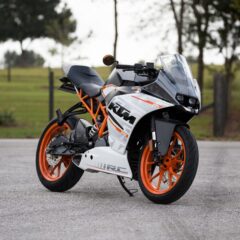
7 Top Motorcycle Accessories
With Christmas just around the corner, you might be wondering what to get your favourite motorcycle enthusiast or even a little something for yoursel...
 Phoenix Motorcycle Training LTD
Phoenix Motorcycle Training LTD
 Phoenix Motorcycle Training LTD
Phoenix Motorcycle Training LTD

Have you ever found yourself daydreaming about two-wheeled adventures on untamed trails or endless tarmac? The discussion about a trail-riding motorcycle vs road motorcycle is a long-standing one in the motorcycling world. And there’s no clear winner.
And it’s not really a question of which is better. They’re different experiences that answer unique needs for adventure. There’s no right or wrong choice. Whether you’re looking for an adrenaline-fueled challenge on unpaved trails or the endless freedom of the road, we’ll give you the low-down on trail-riding motorcycles vs road motorcycles. To figure out which is right for you, just ask yourself, which calls to you the loudest? Then ask yourself another question; why choose one when you can have both?
Let’s kick-start our comparison of trail-riding motorcycles vs road motorcycles with a closer look at their design. Both will respond to the directions you give, but they’re responding to the terrain you’re in too. Dirt bikes will manage loose surfaces, dips and bumps with ease. A road bike will let you power away from hairy situations and eat up the tarmac like nothing else.
Starting from the ground up, tires keep you rolling on all surfaces. Road motorcycle rubber is wider, smoother and stickier than its off-road brothers. This tire profile gives you a firm grip on asphalt, it’s not so great with loose unpaved surfaces.
Dirt bike tires are narrower and knobbier. This design lets you easily push through rocks, debris and dirt as well as navigate the rutted surfaces you’ll find off-road.
Both types of tyres have a curved profile, unlike car tires. That helps the bike’s steering, letting it lean easily into the twists and turns you’ll take it through.
Light-weight, nimble and narrow is what you’ll get from a trail-riding motorcycle frame. It’s usually a smaller frame than most road motorcycles which allows for easier handling and gives you the essentials for fun off-road. Dirt bikes tend to be stripped back to give you just what you need to conquer the hills and moors without fuss. Typically, you won’t find extra bells and whistles on a trail-riding motorcycle unless you add them yourself.
Road machines and heavier and sturdier. They’re made to go faster and in more comfort, so you get a wider seat. You’ll notice there is less clearance between the front wheel and the body of the bike on a road motorcycle than on a trail-riding machine. The difference in the angle of the forks puts the mass of the bike squarely above the contact patches of the tyres. That makes steering on a road motorcycle slightly different to a dirt bike.
A smooth ride relies on the right suspension. Dirt bikes rely on hydraulic suspension systems to absorb the shocks and bumps with ease. That gives you a smoother experience and takes a little of the pressure off your knees.
Road motorcycles have firmer suspension for greater control at high speeds on paved roads.
Although both types of suspension aim to keep your wheels in contact with the surface below (most of the time), they do it in different ways. That’s because road motorcycle suspension needs to manage potholes, cornering and acceleration effortlessly without losing contact with the road. Dirt bike suspension systems need to handle roots and rocks, and allow the wheels to move freely from the body of the bike, occasionally allowing for a little air.
Now that we’ve delved into the building blocks of different styles of motorcycles, let’s wind our way to the heart of the matter—the riding experience. Both trail-riding motorcycles and road motorcycles call for a dynamic dialogue between you, your machine and the terrain you choose.
On a dirt bike, the dance of traction is a thrilling performance. Your narrower, knobbier tires bite into loose surfaces, granting you traction that’s tenacious and responsive. You’ll be leaning gently into turns, weight shifted strategically to the outer edge of your seat. Every dip and turn is an orchestrated manoeuvre that calls for finesse, balance and awareness of the trail’s challenges.
Shift gears to the open road and you’re looking for a wider bike, with smoother tire grip on the asphalt and a different kind of tenacity. This experience is all about power and control. Whether you’re powering away from a tight spot or hugging the tank in preparation for a sweeping curve, your butt stays glued to the seat and feet anchored to your pegs. That lets you respond with a grace defined by your roadcraft awareness and tailored control.
Ever wondered about the best position for riding on trails versus road riding? Trail-riding motorcycles ask for an upright position about 80% of the time. Standing up emphasises the agility of your bike and gives you greater control. Leaning forward into the undulating trail is the preferred stance. It’s a dynamic experience, demanding constant adjustments as you navigate bumps and jumps with finesse. Not to mention strong thighs and calves!
Your road motorcycle calls for a different posture. That’s seated with thighs hugging the petrol tank. You’ll be micro-adapting your position with subtle, conscious shifts for turns, acceleration, braking, and swerving. It’s a different kind of dance, where you use your weight and steering commands to lean into the turns, aligning wheels with the road ahead. You’ll rarely stand on your street bike, but every seated adjustment needs to be tailored to the road beneath and ahead.
Speed on the trail isn’t about relentless acceleration; it’s about finesse. Dirt bikes are all about off-road prowess and demand smooth, controlled movements. Aggressive throttle or brake inputs will upset your balance on loose surfaces. The lower power and speed of dirt bike riding lets you recover with more ease and avoid potential slides.
It’s a different ballgame on the road. Road motorcycles are built for speed, offering the thrill of controlled acceleration on well-paved expanses. The firmer suspension provides greater control and requires more precision with your commands. It’s a continual balance between being in the now and preparing for the road ahead.
Learning to ride any type of motorcycle opens the door to a world of adventure. Whether it’s rugged trails you dream of or smooth, dark asphalt, understanding the nuances of motorcycling will help you decide where to start. Choosing the best motorcycle starts with figuring out what you want a two-wheeled machine for.
It’s important to note that in the UK, you’ll need a motorcycle licence to tackle Green Lanes on a dirt bike. There are different ways you can go about this, but one of the most straightforward by booking motorcycle licence training with a Phoenix Motorcycle Training school near you. If it’s your first step to licencing you’ll start with a CBT course. After that, you can move on to higher level licences for more powerful motorcycles.
Some people consider off-road riding as the gateway to mastering the art of motorcycling. That’s down to the lower speeds and lack of traffic. Riding on loose surfaces teaches you more about balance and control, they’re fundamental skills for riding any kind of motorcycle.
Most equate this with safer learning conditions, but the differences in trail riding positions, posture and terrain mean it’s not a straight transition from trail to road riding, or vice versa.
Riding a road bike brings a different set of challenges. Think busy streets, faster traffic and understanding road signs. You need to be aware of your surroundings, other road users and potential hazards that range from pot-holes to distracted pedestrians.
Learning to ride on the road means mastering bike control at low and high speeds. Your cornering technique on a road bike is slightly different to off-road riding – counter-steering and leaning into turns as you hug your bike with your thighs are replaced with a lighter touch, lean and forward positioning for trail-riding motorcycles.
The decision of whether to start on a dirt bike or a street motorcycle is down to personal preferences, local riding opportunities, and long-term goals. If you have access to acres of private land to ride a dirt bike, it’s a great opportunity to get comfortable on two wheels. Urban dwellers will get more out of a road bike experience thanks to their location and different opportunities.
Dirt First: Opt for a dirt bike if you crave off-road adventures and want to build a strong foundation in bike control. The skills acquired off-road largely translate to on-road riding, but be aware of the differences in technique and performance.
Street Smarts: Choose a street motorcycle if your primary interest lies in commuting, long rides on paved roads, and being part of the urban motorcycle culture. Street bikes offer the versatility needed for diverse road conditions. Having a motorcycle licence also opens the world of trail riding. You’ll flesh out your riding skills with off-road experience. Booking a day with Phoenix Trails lets you have a taste of both worlds.
Dirt biking can instil fundamental skills. Transitioning from one to the other lets you refine those skills for a well-rounded riding experience. Whichever path you choose, the key lies in embracing the learning process, continually honing your skills and enjoying the unique thrills each type of motorcycle has to offer. We don’t think you should have to choose one, book your motorcycle licence course with us today and enjoy some off-road thrills with Phoenix Trails for the best of both worlds!

With Christmas just around the corner, you might be wondering what to get your favourite motorcycle enthusiast or even a little something for yoursel...

If you love motorcycle riding, you’ve probably daydreamed about riding a motorbike for a living. A professional racer or stunt rider is OK for some...

Getting a UK motorcycle licence can seem a complicated process. Particularly when compared to a driving licence for a car. Whether you choose the pro...
This website uses cookies to personalise content, ads, and analyse traffic, sharing data with partners who may combine it with other information. See our Privacy Policy for more information.